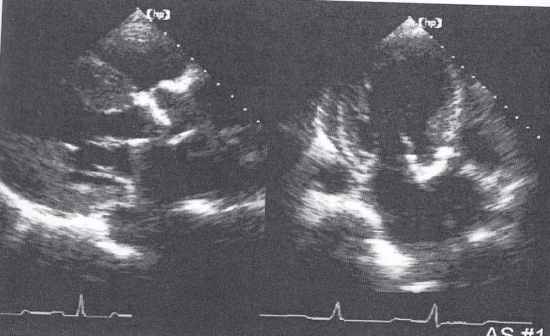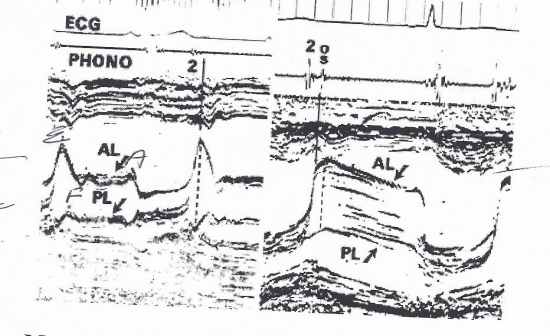Cards In This Set
| Front | Back |
|
List AS Etiology
|
Calific / degenerative
50% bicuspid Rhumatic (assocaed with MS) (thick vales) Congenital (bicuspid 1-2%) Supra valve dysfunction Rhumatic Fever post inflamatoy |
|
Lise AS Pathophysiology
|
Sysotolic pressure overload leads to LVH (increased in afterload) __Increased LVEDP- increased LA size______ Ventricular dysfunction may develop late in the dsease course._____Increased risk or edocardiis_____Aortic sclerosis occurs when there is valvular thickeng but no hemodynamic gradient
|
|
List physical signs of AS
|
Angina-
Dyspnea- Syncope- Sudden Death- Harsh sytolice ejection murmur (RUSB) crescendo-decrescento Decreased or absent A2 (valve doesn't move) Decreased a delye caroticupstroke with bruit / thrill tramitted from AoV Harvis Parvis (weak plse) |
|
Echo of AS |
 Thickened aortic leaflets----------Decreased valve opening--------------Post-stenotic dilatation of the aorta - thought to be caused by abnornal turbulence and wall stress (remember there is low pressure in the aorta (systolis BP) but high pressure in the LV)-------------LVH |
|
Normal velocity for AS is
|
200 cm/sec
|
|
What are the symptoms of severe AS
|
Angina___Dyspnea ____Syncope___Sudden Death____Shortness of Breath
|
|
A secondary finding of AS is
|
LA enlargement____ LV enlargment____LVH____ Increased afterload
|
|
In AS is the pulse pressure wide or narrow
|
Narrow
|
|
What is the cut off for severe AS
|
<1
|
|
What is the cut off for Aortic jet velocity for severe AS
|
>4
|
|
What is the Etiology of Mitral Stenosis
|
Rheumatic (commissarial fusion most common)_______Congenital (parachute rare)_____Acquired (MAC)_____Prosthetic valve dysfunction
|
|
What is the pathophysiology of MS
|
Diffuse leaflet thickening, scarring, contraction, commissural fusion and chordae shortening and fusion.----------Associated mitral regurgitation may be present-------Increased left atrial pressure causes LA dilatation--------Long standing obstruction leads to pulmonmary hypertension (RV & RA enlargement)---------Decrease in cardiac output---------Acute rheumatic fever: beta hemolytic strep, polyarthritis, fever, subcutaneous nodules, carditis and a rash (45% develop MS)------Increased risk for endocarditis.
|
|
Physical signs of MS
|
Diastolic murmur (rumble) with opening snap-----Atrial fibrillation is common-----------CHF symptoms (dyspnea, fatigue, orthopnea, peripheral edema)------Hemoptysis (bloody sputim).
|
|
ECHO of MS
|
Thickened MV leaflets with decreased mobility------- Tethered MV leaflet tips ("hockey stick" presentation----Left atrial enlargement-----Signs of pulmonary hypertenson in advaced disease-----Planimeter valve are in parasternl SAX view-----RV and RA enlargemet.
|
 M-Mode of MS |
1. Decreaed E-F slope-----2. Anterior motion f the posterior leaflet-----3. Reduced amplitude of the E wave-----4. Multiple echos
|



